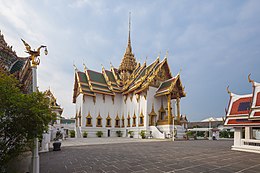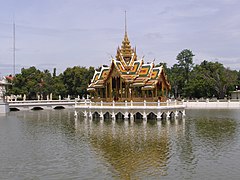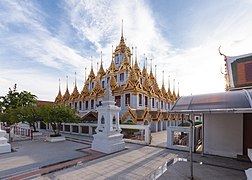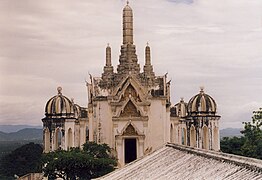Prasat (Thai architecture)

A prasat (
Buddha.[1][2] Prasat forms are widely used in the buildings of the Grand Palace, and are also found in some Buddhist temples (wat) and in the architecture of the temporary crematoria used for royal funerals
.
Architectural historians have classified kudakhan into several categories, according to the shape of the spire:
Gallery
Mondop-shaped
-
Sutthaisawan Prasat Throne Hall, Grand Palace
-
Aphon Phimok Prasat Pavilion, Grand Palace
-
Rueanyot Borom Mangkhalanusorani, Dusit Palace
-
Aisawan Thipphaya-at Pavilion,Bang Pa-in Palace
-
Royal crematorium of Princess Bejaratana
-
Loha Prasat, Wat Ratchanatdaram
Prang-shaped
-
Wetchayan Wichian Prasat Throne Hall,Phra Nakhon Khiri
-
Prasat Phra Thep Bidon, Wat Phra Kaew
-
Wat Phichayayatikaram
Mongkut-shaped
-
Wihan Yot, Wat Phra Kaew
-
Phra Mondop, Wat Pho
See also
- Pyatthat – Burmese equivalent
References
- ^ Royal Society. พจนานุกรมฉบับราชบัณฑิตยสถาน [Royal Institute Dictionary] (in Thai).
- ^ ISSN 2697-3901. Retrieved 28 January 2020.
- ISBN 974-53-2626-7.











